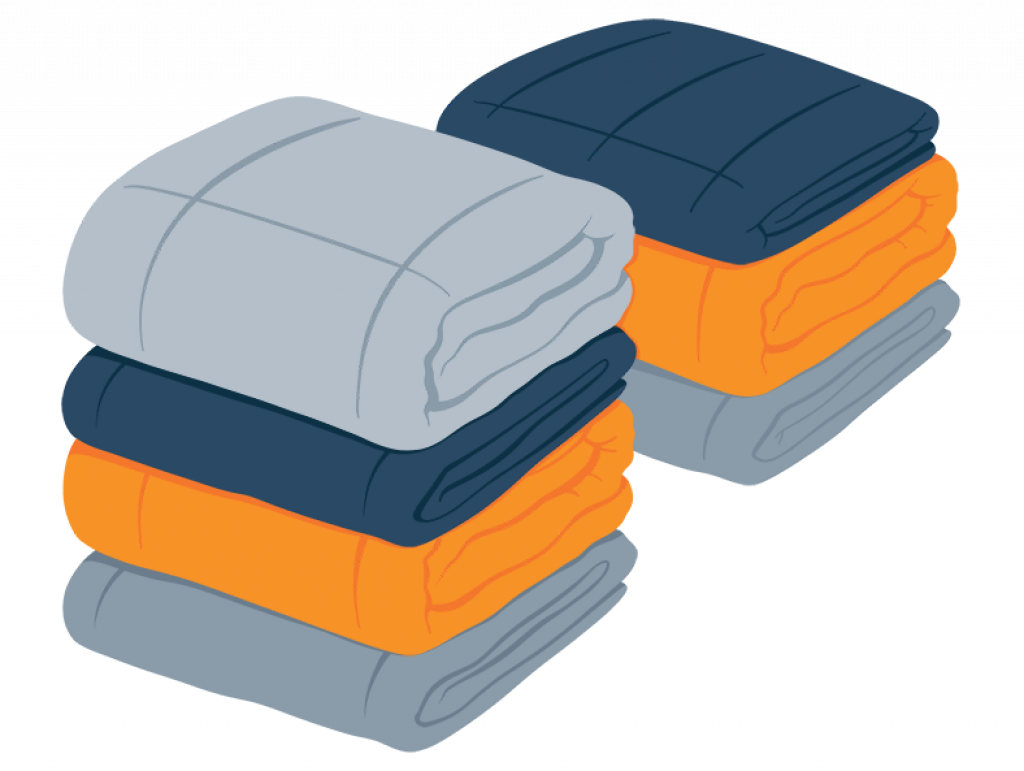Why do some people prefer quilts over comforters and vice versa? For a simple product, bedding can present big decisions. Sleep is critical for our wellbeing, so having bedding that keeps us warm and comfortable at night to support our rest is equally essential.
Quilts can be easily overlooked for large, fluffy comforters. However, quilts bring a lot of unique benefits. Comforters are excellent for warmth, but quilts could present a cooler solution for hot sleepers; plus, they’re easier to store because they fold up nicely as well.
Below we’ll detail the differences between comforters and quilts and which might be best for your needs.
What Is the Difference Between a Quilt and a Comforter?
A comforter is a blanket with thick filling, often made of duck or goose feathers, also known as “down.” Natural feathers are well known for their insulative properties; however, quality alternative down fill can be just as warm.
View Our Guide: Top Rated Comforters
Quilts are considerably thinner products and not as bulky as comforters; they’re great for storage and often don’t trap heat as easily.
Material
Comforters are typically made with soft material on the outer layers and a thick, soft fill for warmth. If you sleep cool at night but prefer feeling warm and cozy, a down comforter will likely be an excellent bet for your needs. The fill is often made of duck or goose feathers or alternative faux feathers.
Want to see more? Read our full guide to the best down alternative comforters.
Quilts are made with two outer layers with batting in between for warmth. The top outer layer makes these blankets unique, with different fabric pieces stitched together to create a beautiful and ornate design, they are often special to their owners.

Maintenance
Comforters should be washed with care. Be sure to read the instructions on the label and put your washing machine on a gentle cycle to avoid potential damage.
You can wash quilts in a washing machine; however, some experts warn against doing this as these blankets vary significantly in strength. Old ones, in particular, could become damaged in a washing machine. Alternatively, you can wash them by hand or take them to a dry cleaner.
Warranty
Warranties can be excellent product savers, especially if you foresee rambunctious children putting your blanket through the wringer. If your blanket or comforter becomes damaged during use, check the warranty and see how long it’s good for and under what circumstances the blanket is covered. For example, if you’ve washed your blanket and it rips in the washing machine, but the label recommended doing so, the manufacturer might replace the product.

Cost
Depending on the quality, both types of products could have prices that vary significantly. The higher quality the fabric or fill is in a blanket, the pricier it could be. However, don’t let this deter you; you can find perfectly suitable products at varying price points.
An alternative down comforter at a reasonable cost could last for years when properly cared for and protected in a cover.
Who Might Prefer a Quilt?
Hot sleepers
Waking up hot, sweaty, and sticking to your covers is an uncomfortable feeling, so if you’re a warm sleeper, comforters might be too warm for your body temperature.
The insulation capabilities of down fill or alternative down are known for their efficiency, so a quilt could be a cooler choice. These blankets, while heavy, often don’t retain as much heat as fluffy comforters, but they can be layered as needed for colder nights.
Fans of layers
Quilts are often overlooked for being traditional in aesthetics, but they have plenty of positives to consider, like weight, easy folding, and layering.
Some individuals enjoy the feeling of heavy layers. Snoozing under multiple lofty layers or products like weighted blankets has gained popularity due to their comforting abilities. If you enjoy layering up under heavy blankets, these are an excellent product to provide this soothing sensation.

Who Will Prefer Comforter?
People Who Can’t Stand Colder Nights
A comforter might be just what you need if you run cold. Those who feel chilly without substantial layers at night should a comforter brings. These blankets are great for cold evenings because they are often made with duck feathers, goose feathers, or alternative down fill, all of which retain warmth well.
If you’re the type who insists on wearing thermal pajamas and warm socks to bed, a comforter may allow you to snooze more comfortably under fewer layers.
Fans of Fluffy Materials
Comforters are widely considered to be, well, comforting. Their design’s soft fluffy sensation allows users to be gently soothed and warmed in their beds as they drift off to dreamland, keeping sleepers warm and cozy without the heaviness quilts bring.
Additionally, some individuals experience a “trapped” feeling when snoozing under heavy material. A lightweight blanket could provide a solution to this discomfort while still keeping you warm.

Frequently Asked Questions
Which one is lighter – quilt or comforter?
Quilts are substantially heavier than comforters due to the type of material and fill they employ. These blankets have two layers of fabric surrounding a layer of batting, which is used for warmth.
On the other hand, comforters are made with lightweight fabric and feathers on the inside for warmth. If they don’t have feathers, the alternative down or alternative fill is typically light.
Remember that just because quilts pack up smaller or thinner than comforters, this doesn’t mean they don’t retain heat. These can still provide excellent bedding for cold nights; however, you may need to layer up.
Can you use a quilt and a comforter together?
Using a quilt and comforter together could provide an excellent combination of warmth and comfort. If you enjoy the weight a quilt provides but need additional warmth without the additional weight, a comforter could be a great extra layer to keep you cozy during cold seasons.
On the other hand, if you enjoy using a comforter due to its insulation capabilities but enjoy the heaviness a quilt brings, you could potentially layer one on top. The heaviness these provide can be highly comforting to some individuals, and the combination could allow you to enjoy the best of both worlds.

Rachael Gilpin
Content Writer
About Author
Rachael is a content writer for Sleep Advisor who loves combining her enthusiasm for writing and wellness.
Back Sleeper
